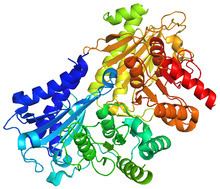EC number 3.1.3.37 ExPASy NiceZyme view | CAS number 9055-32-7 | |
 | ||
Sedoheptulose-bisphosphatase (also sedoheptulose-1,7-bisphosphatase or SBPase) (EC 3.1.3.37) is an enzyme that catalyzes the removal of a phosphate group from sedoheptulose 1,7-bisphosphate to produce sedoheptulose 7-phosphate. SBPase is an example of a phosphatase, or, more generally, a hydrolase. This enzyme participates in the Calvin cycle.
Contents
Structure
SBPase is a homodimeric protein, meaning that it is made up of two identical subunits. The size of this protein varies between species, but is about 92,000 Da (two 46,000 Da subunits) in cucumber plant leaves. The key functional domain controlling SBPase function involves a disulfide bond between two cysteine residues. Additionally, SBPase requires the presence of magnesium (Mg2+) to be functionally active. SBPase is bound to the stroma-facing side of the thylakoid membrane in the chloroplast in a plant. Some studies have suggested the SBPase may be part of a large (900 kDa) multi-enzyme complex along with a number of other photosynthetic enzymes.
Regulation
SBPase is involved in the regeneration of 5-carbon sugars during the Calvin cycle. Although SBPase has not been emphasized as an important control point in the Calvin cycle historically, it plays a large part in controlling the flux of carbon through the Calvin cycle. Additionally, SBPase activity has been found to have a strong correlation with the amount of photosynthetic carbon fixation. Like many Calvin cycle enzymes, SBPase is activated in the presence of light through a ferredoxin/thioredoxin system. In the light reactions of photosynthesis, light energy powers the transport of electrons to eventually reduce ferredoxin. The enzyme ferredoxin-thioredoxin reductase uses reduced ferredoxin to reduce thioredoxin from the disulfide form to the dithiol. Finally, the reduced thioredoxin is used to reduced a cysteine-cysteine disulfide bond in SBPase to a dithiol, which converts the SBPase into its active form.
SBPase has additional levels of regulation beyond the ferredoxin/thioredoxin system. Mg2+ concentration has a significant impact on the activity of SBPase and the rate of the reactions it catalyzes. SBPase is inhibited by acidic conditions (low pH). This is a large contributor to the overall inhibition of carbon fixation when the pH is low inside the stroma of the chloroplast. Finally, SBPase is subject to negative feedback regulation by sedoheptulose-7-phosphate and inorganic phosphate, the products of the reaction it catalyzes.
Evolutionary Origin
SBPase and FBPase (fructose-1,6-bisphosphatase) are both phosphatases that catalyze similar during the Calvin cycle. The genes for SBPase and FBPase are related. Both genes are found in the nucleus in plants, and have bacterial ancestry. SBPase is found across many species. In addition to being universally present in photosynthetic organism, SBPase is found in a number of evolutionarily-related, non-photosynthetic microorganisms. SBPase likely originated in red algae.
